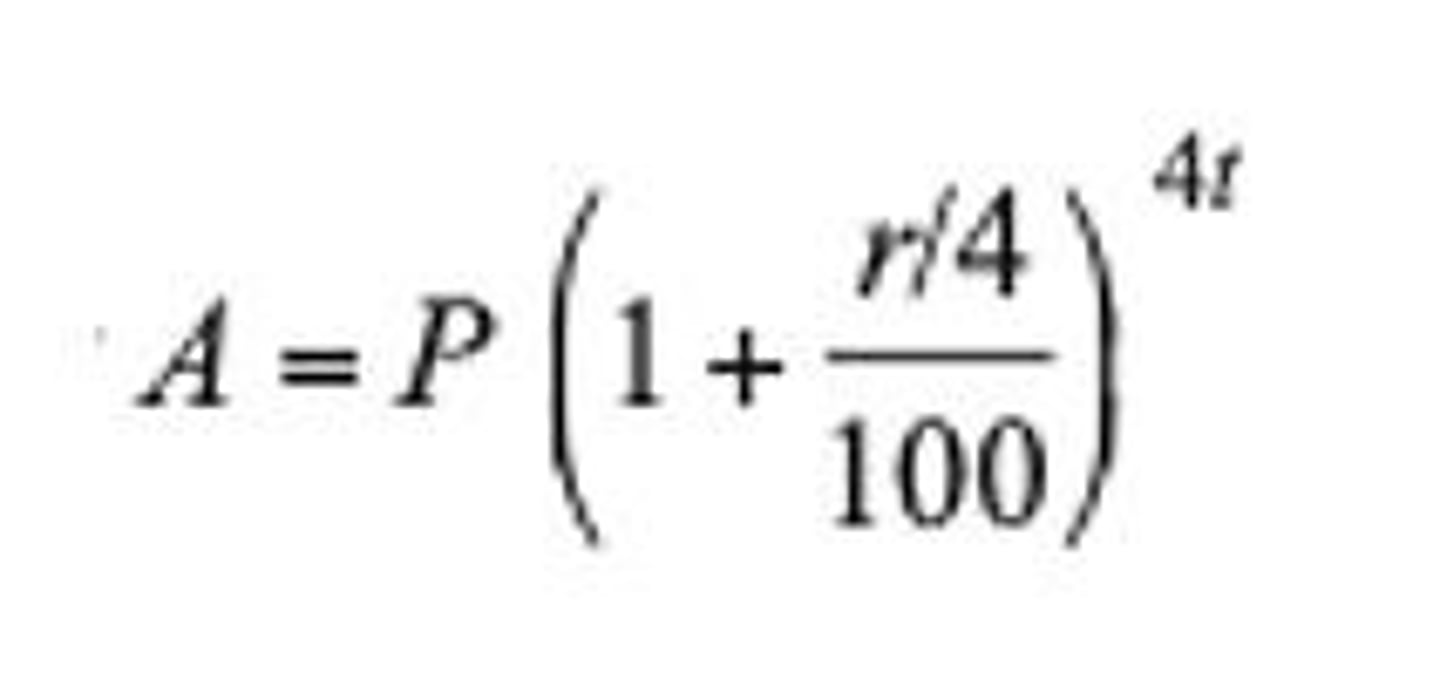Comprehensive CAT Formula Reference 2024
1/139
There's no tags or description
Looks like no tags are added yet.
Name | Mastery | Learn | Test | Matching | Spaced |
|---|
No study sessions yet.
140 Terms
Sum of first n natural numbers
n(n+1)/2
Sum of squares of first n natural numbers
n(n+1)(2n+1)/6
Sum of cubes of first n natural numbers
[n(n+1)/2]^2
Sum of first n odd numbers
n^2
Dividend
(Divisor x Quotient) + Remainder
Profit Percentage
(Profit/Cost Price) x 100
Loss Percentage
(Loss/Cost Price) x 100
Selling Price
Cost Price + Profit
Selling Price (Loss)
Cost Price - Loss
Cost Price (Profit)
Selling Price - Profit
Cost Price (Loss)
Selling Price + Loss
Profit
Selling Price - Cost Price
Loss
Cost Price - Selling Price
Discount
Marked Price - Selling Price
Discount Percentage
(Discount/Marked Price) x 100
Marked Price (Selling Price)
Selling Price/(1 - Discount Percentage/100)
Marked Price (Cost Price)
Cost Price/(1 - Profit Percentage/100)
Profit Percent
Profit x 100 / C.P.
Loss Percent
Loss x 100 / C.P.
Selling Price (Profit)
Cost Price (100 + Profit%) / 100
Loss%
(x/10)²
Value of Loss
2x²S / (100² - x²)
HCF of A, B and C
The highest divisor which can exactly divide A, B, and C
LCM of A, B and C
The lowest dividend which is exactly divisible by A, B, and C
Other number
LCM x HCF / 1st number
HCF of fractions
HCF of the numerators / LCM of the Denominators
LCM of fractions
LCM of the numerators / HCF of the Denominators
Simple Interest (SI)
SI = Prt/100
Amount (A)
A = P + Prt/100 = P(1+rt/100)
Compound Interest (CI)
CI = A - P
Amount for Compound Interest
A = P(1+r/100)ⁿ

Half-yearly Compound Interest
A = P(1+r/2/100)²t
Quarterly Compound Interest
A = P(1+r/4/100)⁴t
Difference between CI and SI for two years
p(r/100)²
Difference between CI and SI for three years
p(r/100)² (r/100+3)
Depreciation
When the value of an item decreases in terms of currency
Initial value of the article (Vi)
The starting value before depreciation
Final value of the article (Vf)
The value after depreciation
Rate of interest (r)
The rate at which the price of article decreases over time period 't'
Work Done
Time Taken × Rate of Work
Rate of Work
1 / Time Taken
Time Taken
1 / Rate of Work
A's 1 day's work
1/n if A can finish the work in n days
Work done by A and B
1/x + 1/y if A can do work in x days and B in y days
Time taken by A and B
(xy) / (x + y)
Speed
Distance/Time
Average Speed
(Total distance travelled) / (Total time taken)
Distance
Speed X Time
Average
(Sum of observations) / (Number of observations)
New average after adding m numbers
(nA + mB) / (n + m)
New average after increasing each number by x
(nA + nx) / n
New average after decreasing each number by x
(nA - nx) / n
Product rule
a^m × a^n = a^(m+n)
Quotient rule
a^m / a^n = a^(m-n)
Power rule
(a^m)^n = a^(m×n)
Negative exponent rule
a^(-m) = 1 / a^m
Rational exponent rule
a^(m/n) = nth root of a^m
Fractional exponent rule
a^(p/q) = qth root of a^p
Surds multiplication rule
√a × √b = √(ab)
Surds division rule
√a / √b = √(a/b)
Logarithm definition
If x>0 and b is a constant (b≠1), then y = log bx if and only if x = by.
Logarithmic identity (product)
Log b(xy) = log bx + log by
Logarithmic identity (quotient)
Log b(x/y) = log bx - log by
Logarithmic identity (power)
Log b(x^p) = p log bx
Logarithmic identity (base)
Log b1 = 0
Logarithmic identity (same base)
Log bb = 1
Change of base formula
log b(x) = log a(x) / log a(b)
Common logarithm
log10(x) = log(x)
Natural logarithm
log e(x) = ln(x)
De Morgan's Law
(A ∩B)' = A' U B' and (A U B)' = A' ∩B'
Cardinality of a set
The number of elements in a set is called its cardinality.
Union of sets
A U B = {x: x ∈A or x ∈B}
Intersection of sets
A ∩B = {x: x ∈A and x ∈B}
Complement of a set
A' = {x: x ∉A}
Difference of sets
A - B = {x: x ∈A and x ∉B}
Cartesian product of sets
A × B = {(a, b): a ∈A and b ∈B}
n( A ∪B )
n(A) +n(B) - n (A ∩B)
n(A∪B)
n(A)+n(B) {when A and B are disjoint sets}
n(U)
n(A)+n(B)-n(A∩B)+n((A∪B)c)
n(A−B)
n(A∩B)−n(B)
n(Ac)
n(U)−n(A)
n(PUQUR)
n(P)+n(Q)+n(R)-n(P⋂Q)-n(Q⋂R)-n(R⋂P)+n(P⋂Q⋂R)
Commutative Laws
A B = B A
Associative Laws
(A B) C = A (B C)
Distributive Laws
A (B ∩C) = (A B) ∩(A C)
Identity Laws
A = A
Complement Laws
A Ac = U
Sine
Opposite/ Hypotenuse
Cosine
Adjacent/ Hypotenuse
Tangent
Opposite/ Adjacent
Secant
Hypotenuse/ Adjacent
Cosecant
Hypotenuse/ Opposite
Cotangent
Adjacent/ Opposite
Sum and Difference Formulas
sin(u + v) = sin(u)cos(v) + cos(u)sin(v)
Reciprocal Identities
cosec θ = 1/sin θ
Circumference of circle
2πr
Area of circle
πr2
Length of arc
θ/360×2πr
Area of Sector
θ/360×πr2
Area of Segment
θ/360×πr2-1/2×r2×sinθ